Buda
Buda (Hungarian pronunciation: [ˈbudɒ]; German: Ofen, Serbo-Croatian: Budim / Будим, Czech and Slovak: Budín, Ottoman Turkish: بودین, romanized: Budin) was the historic capital of the Kingdom of Hungary and, since 1873, has been the western part of the Hungarian capital Budapest, on the west bank of the Danube. Buda comprises a third of Budapest's total territory and is mostly wooded. Landmarks include Buda Castle, the Citadella, and the president of Hungary's residence, Sándor Palace.
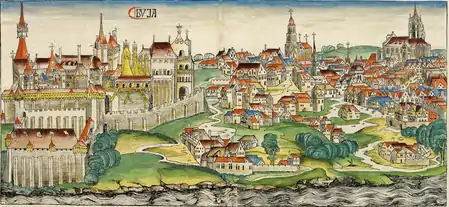
Etymology
According to a legend recorded in chronicles from the Middle Ages, the name "Buda" comes from the name of Bleda (Hungarian: Buda), brother of Hunnic ruler Attila.
Attila went in the city of Sicambria in Pannonia, where he killed Buda, his brother, and he threw his corpse into the Danube. For while Attila was in the west, his brother crossed the boundaries in his reign, because he named Sicambria after his own name Buda's Castle. And though King Attila forbade the Huns and the other peoples to call that city Buda's Castle, but he called it Attila's Capital, the Germans who were terrified by the prohibition named the city as Eccylburg, which means Attila Castle, however, the Hungarians did not care about the ban and call it Óbuda [Old Buda] and call it to this day.
The Scythians are certainly an ancient people and the strength of Scythia lies in the east, as we said above. And the first king of Scythia was Magog, son of Japhet, and his people were called Magyars [Hungarians] after their King Magog, from whose royal line the most renowned and mighty King Attila descended, who, in the 451st year of Our Lord’s birth, coming down from Scythia, entered Pannonia with a mighty force and, putting the Romans to flight, took the realm and made a royal residence for himself beside the Danube above the hot springs, and he ordered all the old buildings that he found there to be restored and he built them in a circular and very strong wall that in the Hungarian language is now called Budavár [Buda Castle] and by the Germans Etzelburg [Attila Castle]
Demographics
.svg.png.webp)

The Buda fortress and palace were built by King Béla IV of Hungary in 1247, and were the nucleus around which the town of Buda was built, which soon gained great importance, and became in 1361 the capital of Hungary.[4]
While Pest was mostly Hungarian in the 15th century, Buda had a German majority;[5] however according to the Hungarian Royal Treasury, it had a Hungarian majority with a sizeable German minority in 1495.[6] Buda became part of Ottoman-ruled central Hungary from 1541 to 1686. It was the capital of the province of Budin during the Ottoman era. By the middle of the seventeenth century Buda had become majority Muslim, largely resulting from an influx of Balkan Muslims.[7]
In 1686, two years after the unsuccessful siege of Buda, a renewed European campaign was started to enter Buda, which was formerly the capital of medieval Hungary. This time, the Holy League's army was twice as large, containing over 74,000 men, including German, Dutch, Hungarian, English, Spanish, Czech, French, Croat, Burgundian, Danish and Swedish soldiers, along with other Europeans as volunteers, artillerymen, and officers, the Christian forces reconquered Buda (see Siege of Buda).
After the reconquest of Buda, bourgeoisie from different parts of southern Germany moved into the almost deserted city. Germans — also clinging to their language — partly crowded out, partly assimilated the Hungarians and Serbians they had found here.[5] As the rural population moved into Buda, in the 19th century Hungarians slowly became the majority there.
Notable residents
.jpg.webp)
- Andrew III of Hungary, (ca.1265–1301) King of Hungary and Croatia, 1290 to 1301, buried in the Greyfriars' Church, a Franciscan church in Buda
- Jadwiga of Poland, (ca.1373–1399), born in Buda, first female monarch of the Kingdom of Poland
- John Corvinus (1473–1504) illegitimate son of Matthias Corvinus, King of Hungary, and his mistress, Barbara Edelpöck.[8]
- Louis II of Hungary (1506–1526) King of Hungary, Croatia and Bohemia from 1516 to 1526.[9]
- Aaron ben Joseph of Buda (ca. 1686), poet
- Mihail G. Boiagi, (1780 – ca.1842) an Aromanian grammarian and professor
- László Szalay (1813–1864) a Hungarian statesman and historian.[10]
- József Eötvös (1813–1871) a Hungarian writer and statesman.[11]
- Ignaz Philipp Semmelweis (1818–1865), a Hungarian physician and scientist. An early pioneer of antiseptic procedures, he proposed doctors start the practice of washing hands.[12]
- Kornelije Stanković, (1831–1865) notable Serbian composer, born and died in Buda
- Edmund Hauler (1859–1941), classicist and philologist
Twin cities
 Capestrano, Italy
Capestrano, Italy
Gallery
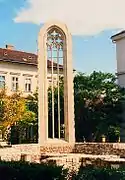
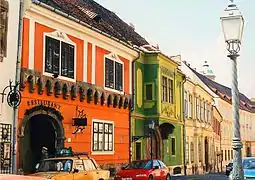 Országház utca (= Parliament Street)
Országház utca (= Parliament Street)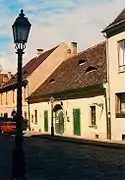 Old Parliament Inn
Old Parliament Inn Buda Main Plaza
Buda Main Plaza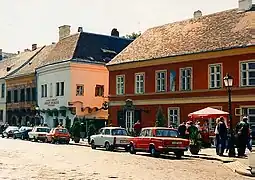 Arany Hordó Inn
Arany Hordó Inn Tárnok utca (= Treasury Street)
Tárnok utca (= Treasury Street)
See also
References
- Mark of Kalt: Chronicon Pictum https://mek.oszk.hu/10600/10642/10642.htm
- Anonymus, Notary of King Béla: The Deeds of the Hungarians https://discovery.ucl.ac.uk/id/eprint/18975/1/18975.pdf
- Nyerges, András, ed. (1998). Pest-Buda, Budapest szimbólumai [Budapest arms & colours: throughout the centuries]. Budapest: Budapest Főváros Levéltára. p. 2.
- This article incorporates text from a publication now in the public domain: Briliant, Oscar (1911). "Budapest". In Chisholm, Hugh (ed.). Encyclopædia Britannica. Vol. 04 (11th ed.). Cambridge University Press. pp. 734–737, see page 737, first two lines.
This fortress and palace were built by King Bela IV. in 1247, and were the nucleus round which the town of Buda was built, which soon gained significant importance, and became in 1361 the capital of Hungary
- "Budapest". A Pallas Nagy Lexikona (in Hungarian). Retrieved 2009-11-03.
- Károly Kocsis (DSc, University of Miskolc) – Zsolt Bottlik (PhD, Budapest University) – Patrik Tátrai: Etnikai térfolyamatok a Kárpát-medence határon túli régióiban, Magyar Tudományos Akadémia (Hungarian Academy of Sciences) – Földrajtudományi Kutatóintézet (Academy of Geographical Studies); Budapest; 2006.; ISBN 963-9545-10-4, CD Atlas
- Faroqhi, Suraiya (1994). "Crisis and Change, 1590–1699". In İnalcık, Halil; Donald Quataert (eds.). An Economic and Social History of the Ottoman Empire, 1300–1914. Vol. 2. Cambridge University Press. p. 440. ISBN 0-521-57456-0.
- Bain, Robert Nisbet (1911). . Encyclopædia Britannica. Vol. 7 (11th ed.). p. 210.
- Bain, Robert Nisbet (1911). . Encyclopædia Britannica. Vol. 17 (11th ed.). pp. 49–50.
- . Encyclopædia Britannica. Vol. 26 (11th ed.). 1911. p. 318.
- Bain, Robert Nisbet (1911). . Encyclopædia Britannica. Vol. 9 (11th ed.). p. 665.
- Allbutt, Thomas Clifford (1911). . Encyclopædia Britannica. Vol. 24 (11th ed.). p. 631.
Further reading
- Richard Brookes (1786), "Buda", The General Gazetteer (6th ed.), London: J.F.C. Rivington
- David Brewster, ed. (1830). "Buda". Edinburgh Encyclopædia. Edinburgh: William Blackwood.
- John Thomson (1845), "Buda", New Universal Gazetteer and Geographical Dictionary, London: H.G. Bohn
- Charles Knight, ed. (1866). "Buda". Geography. English Cyclopaedia. Vol. 2. London: Bradbury, Evans, & Co. hdl:2027/nyp.33433000064794.